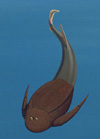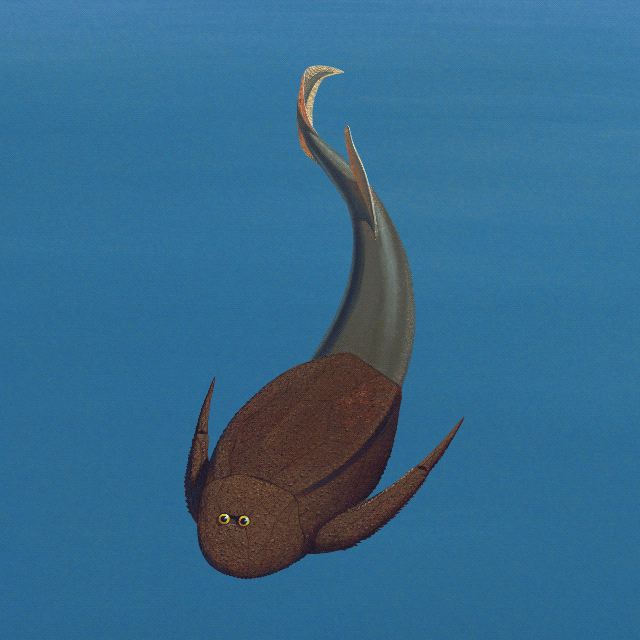Antiarchs
Antiarchs were the second most diverse placoderm group after the arthrodires. They are also the strangest.
 (36 kb) The plates of armour covering the head and thorax joined together to form a heavy closed box with a small anterior opening for the nostrils and two prominent eyes. Another opening on the ventral side near the front served as a mouth. Each pectoral fin was completely clad in bone. In some genera, these bone-covered fins articulated in a manner that is more reminiscent of arthropods, such as crabs, than vertebrates.
(36 kb) The plates of armour covering the head and thorax joined together to form a heavy closed box with a small anterior opening for the nostrils and two prominent eyes. Another opening on the ventral side near the front served as a mouth. Each pectoral fin was completely clad in bone. In some genera, these bone-covered fins articulated in a manner that is more reminiscent of arthropods, such as crabs, than vertebrates.
A benthic mode of living was traditionally attributed to antiarchs, given their flattened profile, the position of the eyes on top of the head, the ventral mouth, and the lumpy appearance that does not suggest an agile swimmer. While probing the bottom sediments for small invertebrates or plant matter, they may have used their “arms” to cover themselves in mud when they needed to hide. These “arms” may also have served as stabilizers, like a type of rudder, while swimming.
But recent discoveries of intact Bothriolepis specimens in Miguasha rocks have shown that their bodies were not as flat as previously thought, and that they had forward-facing eyes.

 (36 kb) The plates of armour covering the head and thorax joined together to form a heavy closed box with a small anterior opening for the nostrils and two prominent eyes. Another opening on the ventral side near the front served as a mouth. Each pectoral fin was completely clad in bone. In some genera, these bone-covered fins articulated in a manner that is more reminiscent of arthropods, such as crabs, than vertebrates.
(36 kb) The plates of armour covering the head and thorax joined together to form a heavy closed box with a small anterior opening for the nostrils and two prominent eyes. Another opening on the ventral side near the front served as a mouth. Each pectoral fin was completely clad in bone. In some genera, these bone-covered fins articulated in a manner that is more reminiscent of arthropods, such as crabs, than vertebrates.A benthic mode of living was traditionally attributed to antiarchs, given their flattened profile, the position of the eyes on top of the head, the ventral mouth, and the lumpy appearance that does not suggest an agile swimmer. While probing the bottom sediments for small invertebrates or plant matter, they may have used their “arms” to cover themselves in mud when they needed to hide. These “arms” may also have served as stabilizers, like a type of rudder, while swimming.
But recent discoveries of intact Bothriolepis specimens in Miguasha rocks have shown that their bodies were not as flat as previously thought, and that they had forward-facing eyes.
Site map | Feedback | Links | Sources | Credits
Antiarchs
<< Placoderms | Bothriolepis >>

Title: Reconstruction of Bothriolepis canadensis
Author: Illustration by François Miville-Deschênes
Sources: Parc national de Miguasha
Year: 2003
Description:
In 1842, Bothriolepis was the first fish discovered at Miguasha. Although originally mistaken for a tortoise, paleontologists realized it was a primitive fish known as a placoderm, which belongs to the antiarch group. Its head, thorax and even its anterior fins were covered by bony plates. Reconstruction by François Miville-Deschêsnes.


